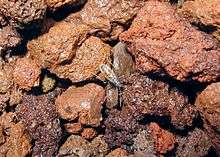Wēkiu bug
| Wēkiu bug | |
|---|---|
 | |
| Scientific classification | |
| Kingdom: | Animalia |
| Phylum: | Arthropoda |
| Class: | Insecta |
| Order: | Hemiptera |
| Family: | Lygaeidae |
| Genus: | Nysius |
| Species: | N. wekiuicola |
| Binomial name | |
| Nysius wekiuicola Ashlock & Gagné, 1983 [1] | |
The wēkiu bug (Nysius wekiuicola) is a species of seed bug, endemic to Hawaiʻi island.
Description
The wēkiu bug is flightless and inhabits the summit area of Mauna Kea, over 12,000 feet (3,700 m). It is named after Puʻu Wēkiu, which means "topmost hill" in the Hawaiian language, the summit peak of Mauna Kea.[2]
Unlike most other lygaeids, which eat seeds, it has adapted to feed on insects that are blown up to the top of the mountain and die. This is not as small a resource as it might seem; snow packs at the summit are often covered with hundreds of them. When the snow melts, wēkiu bugs can be found at the edge feeding on insects that drop out of the melting snow. They have an "antifreeze" in their blood that allows them to survive at low temperatures.
Conservation
The stability of wēkiu bug populations has been a matter of controversy. Development of the summit area of Mauna Kea for telescopes has adversely affected the ecology of the area, including compaction of the loose cinder and spills of chemicals used in maintaining the telescopes. Although the bugs inhabit other cones that are not being built on, hiking and other human activity can have a serious impact on them. An early wēkiu bug survey using lethal pitfall traps collected an unexpectedly large number of specimens, and was accused of depleting the population. Later surveys funded by telescope owners were alleged to have underplayed the impact of development on the bugs. Monitoring of the population, now using non-lethal trapping methods, is ongoing. One difficulty with using baited traps is the limited movement of individuals; a trap immediately adjacent to a melting snowpack may obtain several specimens, while one just a few feet away gets none. Although a petition was filed to list it as an endangered species, in October 2011 the US government declined to designate it as endangered.
The common name is sometimes also used to refer to the closely related Nysius aa, which occupies the same niche on Mauna Loa. It is even more poorly known than N. wekiuicola, but appears to be in less danger since the summit of Mauna Loa is not under threat of development. Although it receives a large number of hikers, the area is largely made up of rocky lava rather than loose cinder, and is less vulnerable to human influence.
References
- ↑ "Nysius wekiuicola Ashlock and Gagne, 1983". Integrated Taxonomic Information System.
- ↑ Lloyd J. Soehren (2004). "lookup of Puu Wekiu". on Hawaiian place names. Ulukau, the Hawaiian Electronic Library. Retrieved August 22, 2010.
Further reading
- Peter D. Ashlock & Wayne C. Gagné (1983). "A remarkable new micropterous Nysius species from the aeolian zone of Mauna Kea, Hawaiʻi island (Hemiptera: Heteroptera: Lygaeidae)" (PDF). International Journal of Entomology. 25 (1): 47–55.
See also
External links
| External identifiers for Nysius wekiuicola | |
|---|---|
| Encyclopedia of Life | 2644270 |
| ITIS | 717888 |